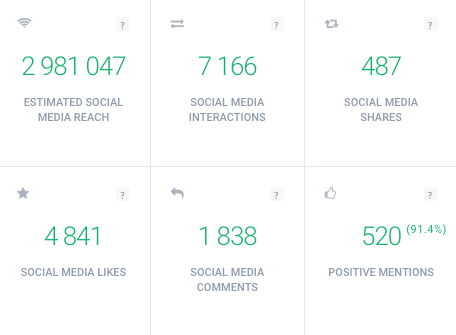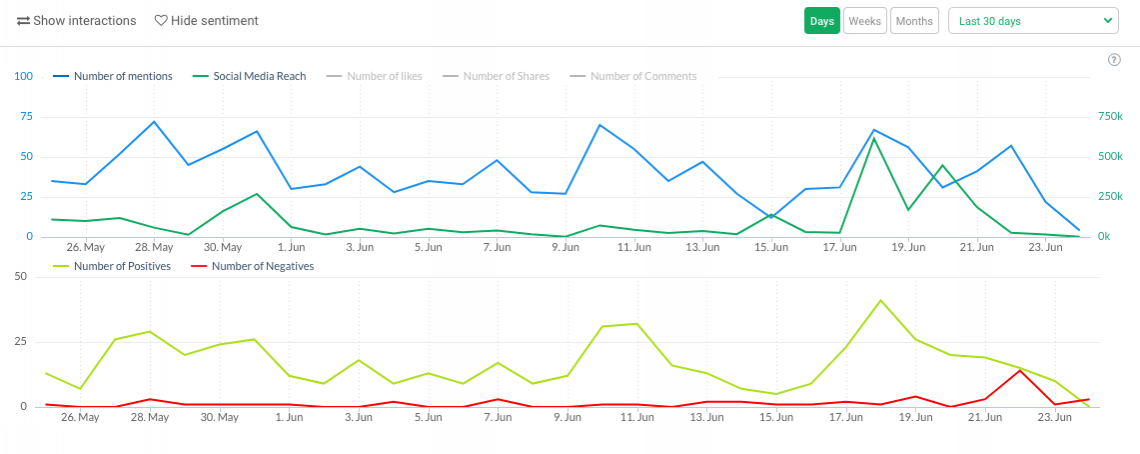11 Social Media KPIs That Will Help You Succeed
Table of contents
Tracking social media KPIs and drawing actionable conclusions is the goal of every social media manager. Carefully chosen key performance indicators will help you improve your social media campaigns. And well-optimised social media campaigns will increase your conversion rate and have a positive impact on your business performance.
But you have to base your decision on data. Especially if you have multiple social media accounts.
With the rise of social media analytics tools, the measurement of social media metrics isn’t a challenge. There are plenty of tools on the market that provide you with various social media KPIs to help asses your social media marketing efforts.
The tricky part is to choose the right metrics to follow. Social media KPIs will help you determine the results of your activities.
If you choose your KPIs carefully, they will not only help determine the success of your social media efforts. Social media KPIs will also pinpoint the areas that need your attention and, ultimately, improvement.
You can use social media to achieve many different goals – drive conversion rate, raise brand awareness, provide excellent customer service, or improve engagement rate.
That’s both the blessing and the curse.
The problem with finding the right metrics to follow is caused by the versatility of social media. You have to keep different measuring social media KPIs for different goals. The more of them are out there, the easier it is to lose track of the ones important for your business.
There are different key performance indicators. The goal is to identify those metrics that will give you ways to assess your efforts and improve your overall social media account performance. You have to assess your goals and decide whether you want to focus on growing the number of followers, decreasing bounce rate, or improving engagement rate.
To make all the social media KPI examples a bit more manageable, I divided them into:
- Social media KPIs for increasing reach
- Social media KPIs for higher engagement
- Social media KPIs to boost conversions
- Social media KPIs for excellent customer service
- The power of social media KPIs
Some of the KPIs will be based on data from our social media listening tool.
Of course, you could find or calculate the data by yourself, but Brand24 will provide much more reliable data and will save a ton of your time.
Track social media KPIs. Start free trial (no credit card required)
Social media KPIs for increasing reach
Reach will tell you how many social media users could have seen your posts.
Increasing reach is worth the effort if you target the right audience with your message. If a lot of people who don’t have any interest in your product or service see your message, they won’t react in the desired way.
Once you determined who is your ideal customer, you can post messages your audience will respond to. Preparing the right social media content will boost your engagement rate which is in direct correlation with reach.
Social media reach
With the help of social listening tool! Brand24 will do all the hard work for you and show you some metrics right in the dashboard, including reach.
Brand24 collects publicly available mentions from different platforms, including:
- YouTube
- Twitch
- TikTok
Besides collecting the mentions, the tool also offers robust analytics that will help your marketing team assess their work.
The fastest and most reliable way to measure reach on different social media platforms is to set up a project in Brand24.
The tool will automatically measure reach on the social media platform you’ve chosen, within your predefined time frame.
Reach is based on the total count and activity of your followers.
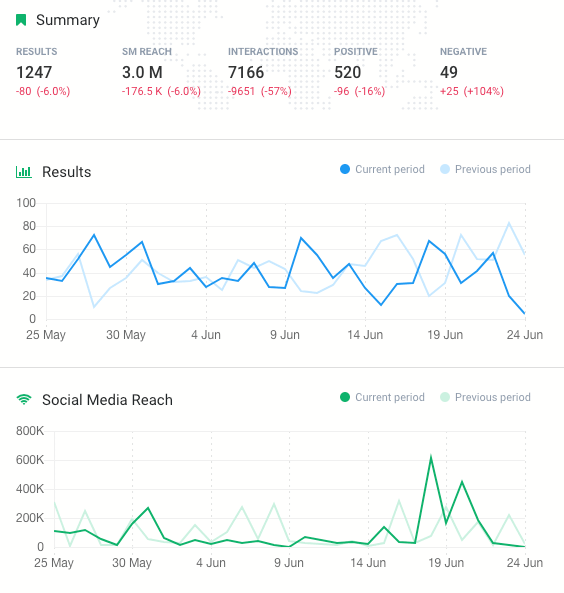
In theory, the higher reach, the better. But, as I mentioned before, it all depends on your audience.
In the long run, it’s better to reach a carefully selected audience, that is more likely to buy your product or service, or even talk about your company than to broadcast your message into the void.
The higher the reach, the higher the virality rate. Your followers will share your content which will boost your reach.
Check: How to increase Instagram reach?
Measure social media KPIs! Start your free trial (no credit card required)
Social media growth rate
Another essential KPI to consider in your social media strategy is the social media growth rate. This metric helps you understand how your social media presence is expanding over time and indicates the effectiveness of your marketing efforts.
The social media growth rate KPI measures the increase or decrease in your follower count across various platforms. Tracking this metric regularly can provide insights into which social media channels are experiencing the most growth and which tactics are resonating with your target audience.
To calculate the audience growth rate, follow these steps:
- Choose a time period for analysis (e.g., monthly or quarterly).
- Determine the initial number of followers for each platform at the beginning of the chosen time frame.
- Record the final number of followers at the end of the period.
- Calculate the difference between the initial and final follower counts for each platform.
- Divide the difference by the initial follower count and multiply by 100 to obtain the growth rate percentage.
Or, if you want to skip all that, take a look at the graph of mentions in Brand24:
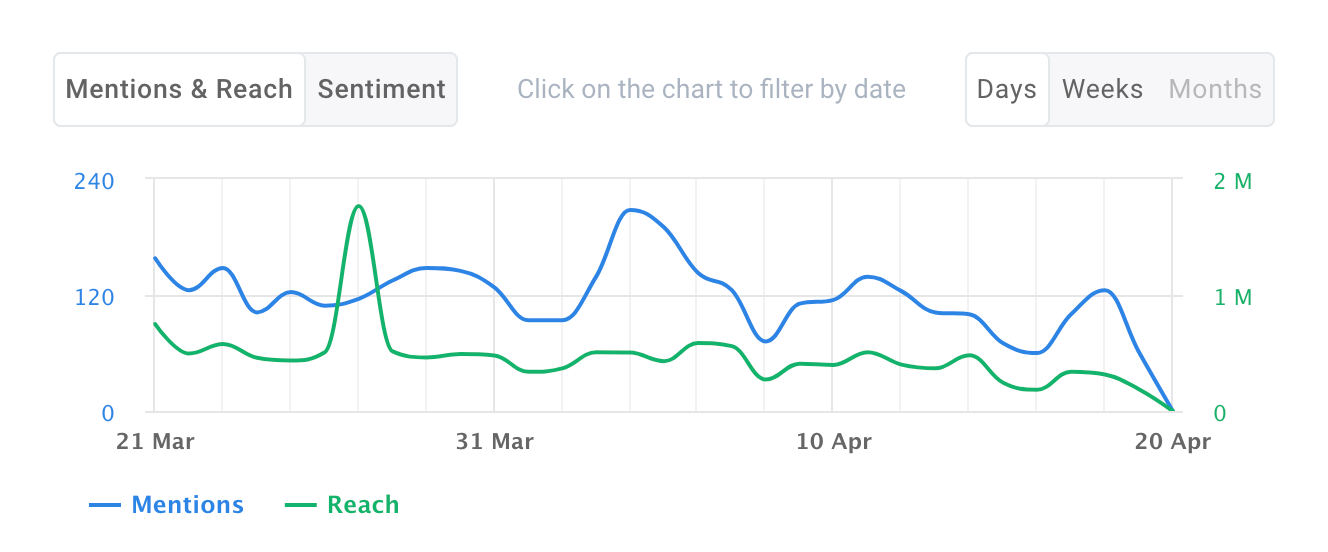
While calculating the social media growth rate manually can provide valuable insights, you can save time and effort by utilizing a tool like Brand24. By taking a look at the graph of internet mentions in Brand24’s dashboard, you’ll have a clear visual representation of your social media growth.
Brand24 automatically collects and analyzes data from various social media platforms, providing you with an up-to-date snapshot of your online presence. The graph of internet mentions serves as a reliable indicator of social media growth, allowing you to easily identify trends and monitor your progress over time.
The share of voice
The share of voice is one of the most important social media metrics for reach.
The share of voice is all about chatter.
This social media KPI shows how much people are talking about your brand online compared to your competitors.
To calculate the share of voice you need to divide the total number of mentions of your project by the total number of mentions regarding your competitors for a social media reporting period.
Or you can take a look at the Analysis tab in Brand24 and compare the share of voice:
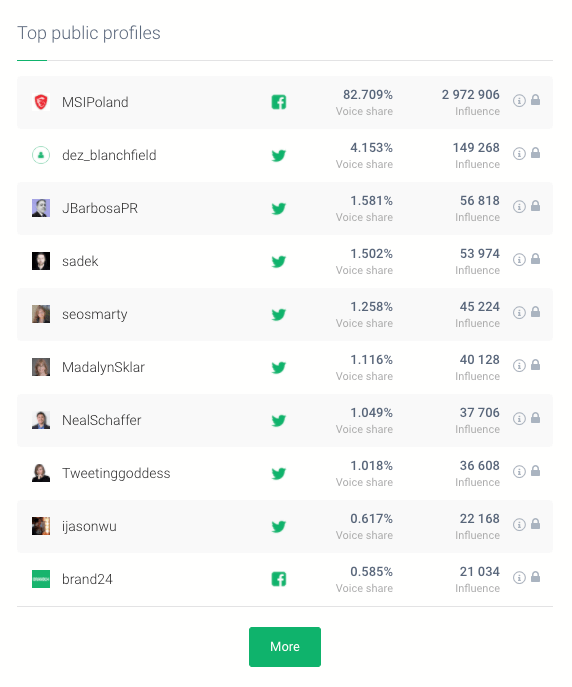
Track social media KPIs. Create your first project!
Being able to spark a conversation around your brand will help you build brand awareness. A loyal community around your brand will translate into more sales opportunities and longer customer lifetime value.
AVE
AVE stands for advertising value equivalent. This KPI will tell you how much value you can get from your PR and marketing activities.
AVE will estimate how much you would have to spend, had the article or post been an advertisement.
Of course, AVE is just an estimation. But it’s a good auxiliary metric that will help you assess the results of your activities.
Web traffic
Social media strategy doesn’t have to focus on boosting your engagement metrics.
You can always direct your customers from your profile to your website or landing page and increase your page views.
If Google Analytics shows an improvement in your web traffic and, you can assume your social media campaign is working to your advantage. Of course, you can improve the content even further by working on bounce rate and click through rate, but social media are your starting point.
More people will get to know your company which will raise your brand awareness. You can always share more information via your website and provide more personalised experience.
Social media KPIs for higher engagement
Once you’ve reached the right people with your campaign, it’s time to make them react to your message.
That’s where we look at other social media key performance indicator – social media engagement.
You don’t want people to only see your posts. In the ideal scenario they react to your content as well.
These social media KPIs will tell you how many likes, comments, and shares your social media posts get.
The better your content resonates with your audience, the more engaged they are. Engaging content will gather higher number of social media impressions and number of clicks which will help you achieve your business goals.
Likes
Can you imagine social networks without thumbs up or hearts?
Track engagement rate! Start your free trial
Likes are the basic metric when it comes to assessing your marketing performance. A high number of likes is an indicator for algorithms to take a deeper look at your content and possibly position it higher on users’ newsfeed.
Analyse what type of social media posts generate high number of impressions and likes. Try to emulate the posts to increase the engagement metrics and, ultimately, the number of followers.
Comments
Comments are a bit more valuable in terms of positioning your messages than likes as it requires more energy to leave a comment than simply hit the like button.
Comments can be a fantastic source of knowledge about your product. Your customers will praise some of the features they find important, but could also leave you hints as what to improve.
Mentions
People are talking about your brand, not only on your social platforms, but also in different places, where you might not be present. Your job is to find those comments and keep an eye on them.
Track online mentions to be aware of changes in the levels of brand awareness.
This social media KPI shows how high your brand awareness and popularity is. Being able to spark a discussion in places where you are not socially active is an indicator of the popularity of your brand.
Social media KPIs to boost conversions
Conversions is what we all, ultimately, look for. Social media should affect your bottom line and increase your conversion rate.
Conversion can mean different things, it all depends on the social media marketing strategy you choose. For some, conversion rate will be a click through rate to the website, for others sign up for a newsletter. Have in mind that conversion rate is not always correlated with income.
Of course, not all of your fans will buy your product or service. But if none of them is buying, then your social media marketing is not fulfilling its purpose.
Revenue from sales
The goal of every company is to make profit. Social media, besides building awareness and serving as a customer service platform, has to bring revenue to your company.
Take a deeper look in Google Analytics and determine what part social networks play in your conversion funnel.
Where does your referral traffic come from? Does your content attract new visitors?
Or maybe you interact more with people who already know your brand?
Social media can be a bait for new customers but also serve as a conversion platform. By identifying the role social media plays in your conversion funnel, you could boost or improve the part to increase your revenue.
Non-revenue conversions
Even if bringing revenue to your company is your bottom line, you can calculate social media conversions in a different way.
Let’s take a look at an example.
Recently, we’ve published an ebook Marketing Full Stack Starter Pack.
In this case, our social media KPI is not only direct sale, but also the number of downloads of the ebook.
The success of your social media campaign depends on the social media goals and KPIs you choose. Your goal might be connected with revenue, but you have to take into account what’s most important to your business strategy.
Non-revenue conversions can be an action trigger that will boost your sales revenue in the long run.
Social media KPIs for excellent customer service
Social media is a great place to offer customer service. Reacting swiftly to your customers queries has many benefits, including:
- showing appreciation to your clients;
- preventing escalation of social media crises;
- turning your customers into brand ambassadors;
- showing a human face to your customers.
Social media can have a beneficial effect on your customer service and building customer loyalty. Closely following some social media KPIs will help you increase the CLV.
Sentiment analysis
Let’s start with sentiment analysis.
Sentiment analysis is jelly to your social media KPI peanut butter sandwich.
It’s important to check how often people talk about your brand, but it’s equally important to know how they feel about your brand.
Track sentiment! Start your free trial (no credit card required)
Sentiment analysis is an important, yet often overlooked, social media KPI.
Sentiment analysis is based on the NLP algorithm (natural language processing). The process helps you assess the feelings behind your followers messaging.
The tool analyses the emotional characteristics of particular words and categorises the mentions into three groups: mentions with positive, negative, or neutral sentiment.
The more positive chatter there is about your brand, the better. Happy and satisfied customers are what’s really important in running a business.
But take a look at the negative mentions as well; they are a goldmine of knowledge. Analyse the issues your customers have and improve what you can.
A surge in the volume of mentions with negative sentiment is an indicator of a social media crisis in the making.
In this case, time is of the essence. Address negative comments quickly and you could turn the tables around and even benefit from it.
Customer lifetime value
Excellent customer service should result in increased customer lifetime value (CLV).
CLV indicates how long your customers stay with you. If you’re running a subscription business, take into account how long particular client stays with you.
If you’re selling material goods, see how often your customers come back and purchase your good or service again.
How can social media help with retaining customer and why is it a social media KPI?
Social media is all about building relations, providing content that resonates with your audience. Your social strategies are directly correlated with CVL.
Solved issues
Sooner or later, your customers will complain about your product. Your job is to find those complaints and resolve the issues your customers have.
One of the tricks of the trade is to react quickly to every message posted on social media channels, even if a customer only mentioned your company name and didn’t use your branded hashtag or company handle.
Great customer service can be a differentiating factor that will set your company apart from your competitors. That’s a great way to increase your CLV and, in the end, increase sales.
The power of social media KPIs
Social media channels are powerful tools that can boost your business objectives and help you achieve your goals. Whether it’s increasing your conversion rate, number of followers, or decreasing bounce rate, social media platforms can help you achieve your goal.
To succeed you need actionable data. Track different social media metrics and make informed decisions about how to boost your social media presence.
Social media KPIs will indicate which form of communication with your target audience works to your advantage. Track the right social media KPIs and you will see results of your actions in your overall business goals.
Want to know more? Read about key social media metrics tracking.
FAQ
What is KPIs for social media?
KPIs, or Key Performance Indicators, for social media are specific metrics used to measure the effectiveness and success of your social media marketing efforts. These KPIs help you track the performance of your campaigns and determine whether you’re achieving your set goals, such as increasing brand awareness, engagement, conversions, or providing excellent customer service.
What are the 5 essential social media metrics?
Reach: Reach refers to the number of unique users who have seen your content. It helps you understand the potential audience size for your social media posts and indicates how well your content is being distributed.
Engagement: Engagement measures how users interact with your content, including likes, comments, shares, and clicks. High engagement indicates that your content resonates with your audience and encourages further interactions.
Follower growth: Follower growth tracks the increase or decrease in the number of your social media followers over time. It helps you assess the effectiveness of your content and overall social media strategy in attracting and retaining an audience.
Click-through rate (CTR): CTR measures the percentage of users who click on a link in your social media post. This metric is particularly important for campaigns aimed at driving traffic to your website or a specific landing page.
Conversion rate: Conversion rate refers to the percentage of social media users who take a desired action, such as making a purchase, signing up for a newsletter, or downloading an eBook. This metric helps you understand how effectively your social media efforts are contributing to your overall business goals.
